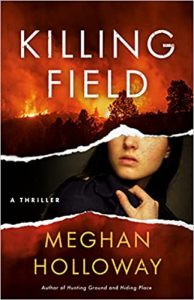Fire and Ice: An Ode to Setting
Fire and Ice: An Ode to Setting
by Meghan Holloway
 I fell in love the first time. I was in my late teens, and I had never before experienced that bitterness of the wind, those depths of snow, or that sheer wildness of a landscape. Yellowstone in the unrelenting grips of winter captured my heart and my imagination.
I fell in love the first time. I was in my late teens, and I had never before experienced that bitterness of the wind, those depths of snow, or that sheer wildness of a landscape. Yellowstone in the unrelenting grips of winter captured my heart and my imagination.
Nothing prepared me for the rawness of the cold, for the way it reached within and flayed the lungs, for the way it crept into the joints and stiffened the sinews. This was a cold that ached, a frigidity that could kill. This was nature at its most haunting and most unforgiving.
I loved it. I had never felt so viscerally alive as I did teetering on the edge of merciless temperatures and an untouched wilderness. I had never felt a desire to test my mettle against a savage landscape before, but this was an invitation to tap into those age-old whispers that have always haunted humankind: Leave behind the comfortable and the familiar. Venture into the unknown. Wander and roam, assuage the explorer’s heart that lies within.
So I strapped on my cross country skis and headed into the wild.
There was an otherworldliness in the snow-laden hush of the woods. The only sound was the whisper of my skis slicing through more than a foot of pristine power that had fallen overnight. The lodgepole pines stood as svelte sentinels in the forest, clothed in green needles with a heavy cloak of white. The stream I skied alongside was frozen solid in the shallows, but farther, where it widened into river and hot springs emitted ghostly eddies of steam, melting the snow along the bank, the water flowed like a melody of deepest gray in the quiet, winter-locked world. Time felt suspended and set adrift over an untouched land.
Diamond dust glittered over the water. Hoarfrost added crystalline feathering to grimly bared, shivering branches. A streak of red against the stark white caught the edge of my vision. When I turned, a fox slipping through the trees stopped and peered over her shoulder at me. Our gazes met, and we both smiled.
That first time I visited, I made a promise to myself as I sat before a roaring fire and unthawed. I would pay homage to this mysterious, deadly, wondrous land in fiction one day. The last time I visited, I saw the wrath of the fire season, terrifying and heartrending and necessary. Yellowstone in all its seasons is an otherworldly, dangerous beauty. But my first and my last visits have lingered with me.
Winter in Yellowstone is where I began HUNTING GROUND, years after I made myself that promise. In Hector’s own words, he describes the season: “Winter was a hardscrabble, gritty season in this part of the country. The wildness was whittled to a fine blade, everything rendered sharper in the cold. This was a land as beautiful as it was dangerous. In other seasons, the beauty could hide the danger. Parred down to bone in the winter, there was no hiding how brutal this land could be. Winter was nature at its hardest and most authentic.”
HIDING PLACE showcased spring in Yellowstone. “Spring was the season of birth, but in this wilderness stretch of the country, death often followed close on the heels of new life. It was brutal and gritty, nature at its grimmest and most bloody.”
The final book in the trilogy, KILLING FIELD, ends in flames. Wildfire season has engulfed Yellowstone, and Raven’s Gap is in the crosshairs.
In each installment in the series, I strove to have the season and the wilderness reflect something about the nature of the characters. HUNTING GROUND explores the harrowing dynamics between predator and prey. HIDING PLACE grapples with the burden and sacrifice of motherhood.
KILLING FIELD, the conclusion, is a quest for retribution and redemption. In Yellowstone, the destruction of the wildfire season is necessary for the ecosystem. Fire aids the decaying process that provides nutrients to the soil. It allows trees to grow stronger and healthier. The iconic lodgepole pines require the high temperatures for the cones to release their seeds.
The brutal cold is the perfect backdrop for a crime thriller, and like my first introduction to Yellowstone, I wanted to introduce the reader to this ecosystem that haunts me in its most raw season. But I’ve written a story in three parts about one man’s dogged search for answers in the disappearance of his wife and daughter. When I began with ice, I knew I would have to end with flames. For fire, in all its devastation, enables growth.
—
Meghan Holloway found her first Nancy Drew mystery in a sun-dappled attic at the age of eight and subsequently fell in love with the grip and tautness of a well-told mystery. She flew an airplane before she learned how to drive a car, did her undergrad work in Creative Writing in the sweltering south, and finished a Masters of Library and Information Science in the blustery north. She spent a summer and fall in Maine picking peaches and apples and traveled the world for a few years.
She now lives on the Atlantic coast with her standard poodle and spends her days as a scientist with the requisite glasses but minus the lab coat. She is the author of ONCE MORE UNTO THE BREACH, HUNTING GROUND, HIDING PLACE, KILLING FIELD, and THE LIBRARY OF LOST SOULS. Follow her on social media at @AMeghanHolloway.
KILLING FIELD, Meghan Holloway
BUY HERE
Category: Contemporary Women Writers, How To and Tips































